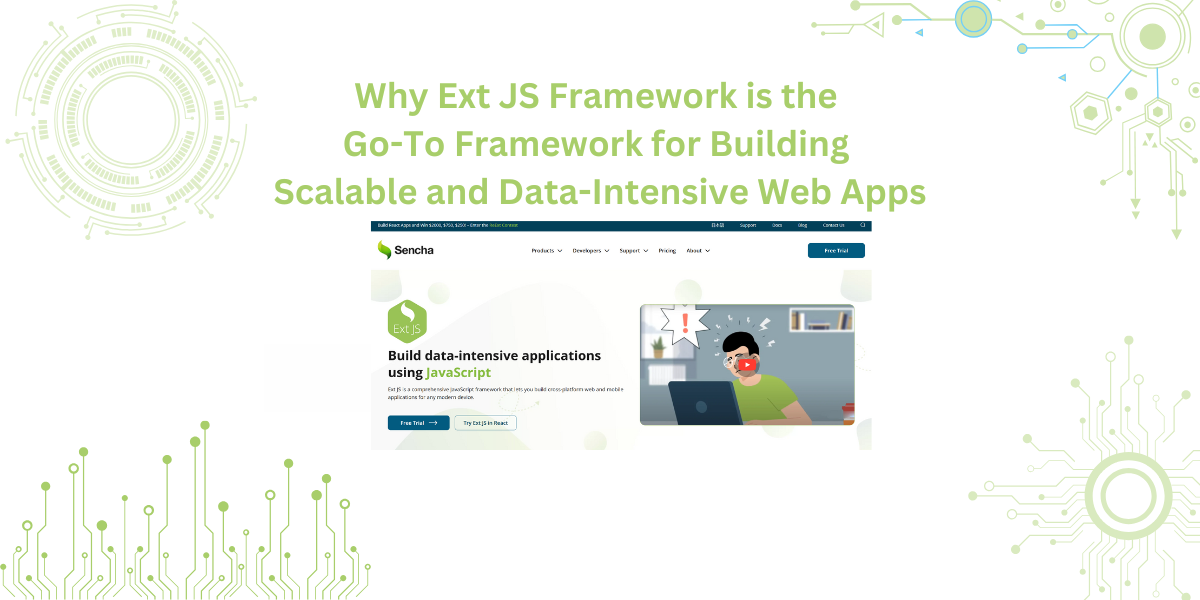Why Ext JS Framework is the Go-To Framework for Building Scalable and Data-Intensive Web Apps
Get a summary of this article:
Web apps are much more advanced now. They deal with large amounts of data and need to stay fast, even with many users. If you’re building something like a finance dashboard or live analytics tool, picking the right JavaScript web framework really matters. It’s really helpful in running everything smoothly and efficiently.

That’s where Ext JS comes in. It’s a favorite among developers for a reason. It runs on HTML, CSS, and JavaScript, but gives you much more. Instead of just tools, you get a full setup that helps you build complex apps without the usual mess. It just makes things easier.
So, why do many call it the best JS framework? Well, it gives you a bunch of ready-to-use UI components that save time and make building easier. Its MVC and MVVM structure make it simpler to handle big projects. It helps in increasing responsiveness and efficiency. There are tools like buffered rendering and virtual DOM that help to achieve this.
If you’re creating something that needs to handle growth, this JavaScript UI framework is ready for it. It includes the security and support that big projects need. That’s why many developers see it as a top choice for serious work. Ext JS stands out when building modern apps that deal with a lot of data.
Why Ext JS Is Ideal For Growing & Scalable Applications
You have to consider scalability from the start if building something that grows. This is especially true for enterprise software, where you’re dealing with lots of users and big data sets. Picking the right JS web framework here really counts.
Some small JavaScript libraries work fine at first, but often struggle as your app grows. Ext JS helps by splitting your app into smaller pieces so it’s easier to handle. It also gives you built-in tools and parts to work with. That way, building flexible and smooth apps feels a lot simpler.
It also takes performance seriously. With server-side and buffered rendering supported by default, your app stays smooth, whether it’s a data-heavy dashboard or a tool with multiple users. That’s not something every JavaScript UI framework can offer.
Ext JS consistently shows up among the most popular JS frameworks, especially for businesses. If you’re making financial tools, internal platforms, or data apps, this is a great JavaScript website framework to try. It’s stable and built to scale as things grow. That’s why many developers go for it when they need something they can count on for the long run.
Efficient Management Of Large Datasets
Handling loads of data in JavaScript apps can feel like too much sometimes. With so many front-end frameworks to pick from, it’s not always simple. Some just don’t make things any easier. Ext JS helps simplify that part. It’s made to handle heavy data without making your app slow or clunky.
It can handle data very nicely. So, what makes it super convenient? Instead of loading everything, it only shows what’s on the screen. As you scroll, the rest loads bit by bit. It feels quicker and easier to use. It makes things feel faster and smoother. Really handy if you’re building a dashboard or something that updates live.
The server takes care of things like sorting, filtering, and paging. That way, your browser doesn’t have to do too much. The app really works nicely, even though there is a lot of data. Even with a lot of data, the app still feels fast. It keeps everything running smoothly without slowing you down.
You don’t need to put in extra effort. It syncs your user interface with data very nicely. It connects easily with REST APIs. Whenever there are changes on the server side, the app automatically updates. You don’t need to reload or wait for the changes to be updated.
If you’re working on tools like stock tracking apps, IoT platforms, or anything else that needs real-time data views, this JavaScript UI framework is a great fit. Among the popular JS frameworks out there, Ext JS shines when it comes to performance with large datasets.
This is not just a JS web framework. It’s a great solution that is designed especially for handling modern apps’ complexities. JavaScript frameworks are everywhere now, so having one that manages both speed and scale really matters. That’s why Ext JS is often seen among the top JS frameworks used today.
Pre-built UI Elements That Eliminate Dev Work
Building UI components from scratch takes a lot of time. Ext JS helps by giving you a big set of ready-made elements. You don’t have to build things from the ground up, which saves a lot of effort.
You get everything from grids and charts to forms, layout tools, and tree views. They’re all built to work smoothly on any device or browser. So, you don’t need any third-party packages; it has all the components and functions built in. Whether it’s a mobile-first app or a full enterprise dashboard, the pieces are already there.
When you stack it up against other popular JS frameworks, Ext JS stands out. It’s one of the top JS frameworks because the whole component library is both deep and flexible. These components aren’t just pretty – they’re fast and reliable, which is key in any serious JavaScript web app framework.
Using Ext JS, you have more time to focus on the core functionality instead of dealing with CSS stuff. This is really helpful for the teams that want fast and efficient solutions. For anyone exploring JS web frameworks or comparing JavaScript libraries and frameworks, Ext JS deserves a close look.
Clean And Scalable Code With The MVC Architecture
As your app grows, so does the code. More features mean more complexity. That’s where the Ext JS MVC and MVVM structure really helps.
It helps to keep things organized. To ensure this, it divides the code into manageable views, models, and controllers. That makes things easier to handle. These models and templates are reusable, which reduces bugs and saves a ton of time.
If you’re someone who likes structure, Ext JS is one of the top JS frameworks to look into. It offers a clean way to build apps and fits nicely with modern tools like template engines. Also, it’s great for building progressive web apps.
Ext JS differs from other well-known JS frameworks in that it facilitates clean code and organization. It’s great for both small projects and large JavaScript web app framework needs. You can manage everything easily as your app grows. That’s why many teams see it as the best JS framework when planning to scale smoothly.
Responsive Design And Cross-Browser Compatibility
Getting your app to look good everywhere really matters now. With Ext JS, you won’t have to worry about screen sizes or browsers. Just write your code once. It works smoothly on Chrome, Firefox, Safari, Edge, and even Internet Explorer. No need to fix things for each browser.
You can build layouts that fit any screen size. It could be a phone, tablet, or computer. The best part? Your app still looks great, and you barely have to change a thing. It has flex layout support, smooth data handling, and features that improve how images load. Everything is designed to keep things simple and work fast. These features save time and keep your app smooth and quick.
If you’re building a single-page application, these built-in tools make a real difference. You get both speed and a polished look without needing to bolt on extra libraries. That’s why Ext JS stands out among the top JS frameworks.
Some JS frameworks do well with responsive design, but Ext JS really stands out for keeping the UI consistent everywhere. Your app looks neat and runs smoothly on any device. That’s important when you’re building tools for businesses or customers. People notice when things just work the way they should.
Application Defender To Protect From Vulnerabilities
Security isn’t just an extra anymore. It’s important even when you start building. Ext JS gets that. It’s built with enterprise-level protection to help you stay compliant and keep user data safe.
Out of the box, you get features like HTTPS enforcement, automatic input escaping, and anti-CSRF tokens. Many frequent security vulnerabilities are resolved by these without requiring additional effort. Additionally, Ext JS updates its core libraries to address known issues and adhere to the most recent security best practices.
That’s a big win compared to many popular JS frameworks that rely on third-party tools for protection. If you’re working on a banking dashboard, healthcare portal, or anything with private data, Ext JS is a great choice. It’s reliable, built for big tasks, and keeps things secure. One of the top JS frameworks for these kinds of projects.
Speeds Up Interaction And Data Rendering
Ext JS stands out as one of the top JavaScript UI frameworks because it really focuses on performance. It keeps things moving fast using features like virtual DOM and lazy loading, which help apps run smoothly without lag.
If your app works with big tables or live data streams, buffered rendering really helps. It just loads the data that’s needed, or you can say visible data. It doesn’t need much memory support. So everything works efficiently and smoothly. Even if you are dealing with huge data, your app doesn’t slow down.
Server-side processing handles the tough stuff first, like sorting and filtering. The server deals with things like sorting and filtering before sending anything to your screen. This ensures the smooth running of even complex applications while keeping the front ends light.
Some lightweight front-end frameworks JS developers use might need extra tweaking to perform well. But Ext JS is already built for speed and stability. If you’re after a reliable JS web framework that handles pressure, this one’s ready to go.
How Sencha Ext JS Developers Stay Ahead Of The Curve
If you’re working with Ext JS, you’re already keeping up with the fast-moving world of web dev. Sencha Ext JS makes it easier by rolling out updates regularly, and the docs are actually helpful. You don’t have to dig forever to find what you need.
There’s also a solid community behind it. People share stuff on GitHub, help each other out in forums, and post little tips that save you time. Whether you’re exploring JS testing frameworks or just starting out, you’re not building things alone.
Ext JS is one of the most popular JS frameworks. It provides strong, efficient components that are perfect for applications that require extensive data. Given the rising popularity of JavaScript frameworks, this is a good choice if you’re looking for a robust and functional JavaScript web app framework.
Community and Support
A solid community can make a framework easier to work with. With Ext JS, you’ve got that. Developers from all over share answers, post code samples, and help out in forums.
Stuck on something? Just search around. There is a possibility that someone had the same problem, and they showed the solution. Sencha also puts out helpful docs and learning tools. If you need direct support, they’ve got that too.
Ext JS is still getting regular updates. Thus, it adapts to new browsers and technological advancements. That is one of the reasons why a lot of developers continue to use it. There is a reason it has remained popular.
Conclusion
Ext JS is a trusted JavaScript UI tool for building web apps. It manages complicated data with efficiency. The layouts work nicely on all types of screens. Additionally, the framework makes it easy to maintain control as your program expands.
Ext JS really helps in keeping things organized using the MVC structure. It’s designed to keep your apps quick and secure so they load fast and work safely without issues. Whether you’re creating a finance dashboard, a data tool, or an internal system, it covers everything you need.
Ext JS is listed among the top JS frameworks because of its performance and stability. It’s fast and has practical application in the real world. If you need a reliable JS web framework with rich UI components and clean performance, Ext JS is definitely worth a look.
FAQs
What are JS frameworks?
You can build apps with these tools using the parts they already include. No need to set everything up yourself. They take care of things like changing pages or refreshing the view. That way, you spend less time on the basics. Using them makes front-end work easier and more organized. They also save a lot of time.
Is React JS a framework?
Technically, React isn’t a complete framework. It’s a UI library for JavaScript. However, it seems like a complete React JS ui framework when used with Redux and React Router. For this reason, it is regarded as one of the best JS frameworks.
What is a framework in software?
A software framework has tools and code that help to build applications faster. You don’t need to build everything yourself. It also helps teams stay organized and follow the same structure throughout the project.
What is the React framework?
When people mention the React framework, they usually mean React, along with tools like Next.js. These work together to build full-stack JavaScript web apps. It’s a go-to setup for front-end development. This mix is also one of the most popular JS frameworks right now.

For Independent Software Vendors operating in competitive global markets, the user interface has evolved from…

The selection of a front end framework for enterprise applications remains one of the most…

Every software project begins with a choice that reverberates through its entire lifecycle: which development…









